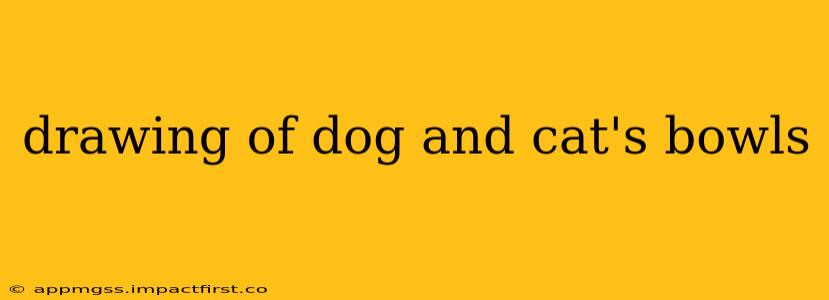Drawing Dog and Cat Bowls: A Guide for Beginners and Beyond
Creating a drawing of dog and cat bowls might seem simple, but capturing the subtle differences in their shapes and sizes, and adding personality to your artwork, can elevate your piece from basic to beautiful. This guide will walk you through various approaches, from simple sketches to more detailed renderings, catering to artists of all skill levels.
What you'll need:
- Paper: Choose a paper suitable for your chosen medium. Sketch paper works well for pencils and charcoal, while watercolor paper is better for water-based paints.
- Pencils: A range of pencils (e.g., HB, 2B, 4B) provides varying levels of darkness for shading and detail.
- Eraser: A kneaded eraser is ideal for lifting pencil marks without damaging the paper.
- Ruler (optional): For achieving perfectly straight lines, particularly when sketching bowls from a side profile.
- Drawing medium of your choice: Colored pencils, crayons, markers, paint – the possibilities are endless!
Understanding the Basics: Shapes and Proportions
Before you start, observe real dog and cat bowls. Notice their typical shapes:
- Dog bowls: Often wider and shallower, sometimes with a slightly flared rim.
- Cat bowls: Frequently smaller and possibly deeper, sometimes with a lip or raised edge to prevent spills.
Consider these aspects:
- Size: A dog bowl is usually considerably larger than a cat bowl.
- Depth: Cat bowls often have a greater depth relative to their diameter compared to dog bowls.
- Material: The material (ceramic, metal, plastic) will affect the reflection of light and how you portray texture in your drawing.
How to draw a simple dog bowl:
- Start with a circle: Draw a slightly elongated circle or oval to represent the top view of the bowl.
- Add the sides: Draw slightly curved lines down from the circle to represent the bowl's sides. The lines should curve inward gently. For a more realistic look, consider how the bowl's sides curve out slightly before narrowing toward the bottom.
- Draw the base: Connect the bottom of the sides with a straight or slightly curved line.
- Add details: You can add a slight lip or a texture to the bowl's surface using shading or hatching.
How to draw a simple cat bowl:
- Start with a smaller circle or oval: Use a smaller circle or oval than the dog bowl.
- Add deeper sides: Draw more deeply curved lines than you did for the dog bowl. The sides should taper slightly towards the bottom. Consider a slightly more pronounced inward curve near the rim for a more realistic cat bowl.
- Draw the base: Connect the bottom of the sides with a straight or slightly curved line.
- Add details: Add details such as a raised rim or slight imperfections in the surface to give the bowl character.
Drawing from different angles:
Drawing from a side profile adds another layer of complexity. You will need to consider perspective and how the bowl's dimensions appear from that viewpoint. Practicing with simple shapes and then gradually incorporating more realistic details is key.
Adding details and texture:
The texture and material of the bowls affect their appearance. For example:
- Ceramic bowls: Show subtle curves and possibly slight imperfections. Use shading to create the appearance of gloss or matte finish.
- Metal bowls: Show smoother, reflective surfaces. Consider how light would reflect off the metal.
- Plastic bowls: Often less reflective with visible lines or patterns.
How to draw multiple bowls side-by-side?
Draw both bowls simultaneously; consider the spatial relationship between them. Pay attention to overlapping and perspective changes.
Adding Food (Optional):
Adding kibble or wet food to the bowls brings your drawing to life. Use simple shapes for kibble and softer shapes and shading for wet food.
By following these steps and experimenting with different techniques, you can create a charming and detailed drawing of dog and cat bowls. Remember to practice and have fun! The more you practice, the better you'll become at capturing the nuances of shape, size, and texture.
